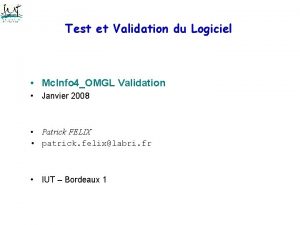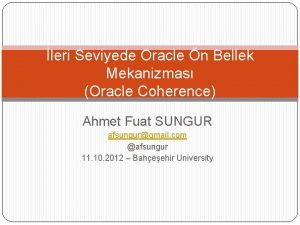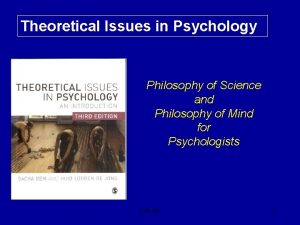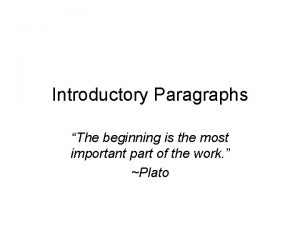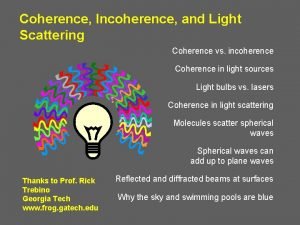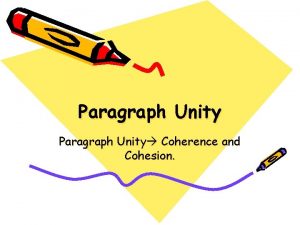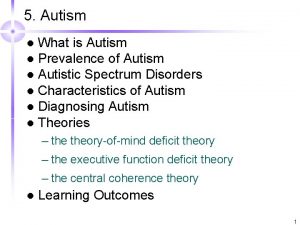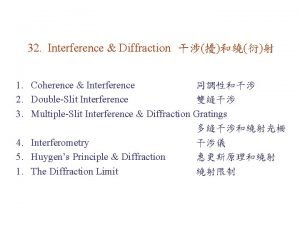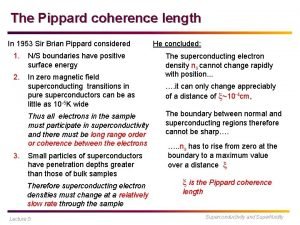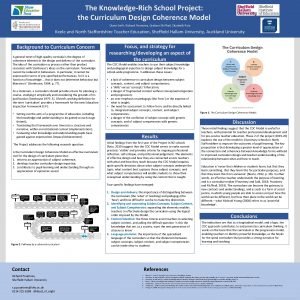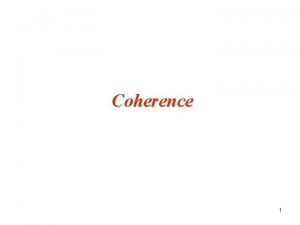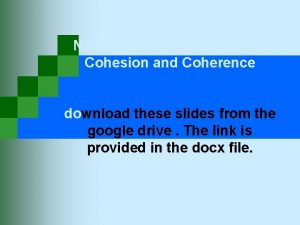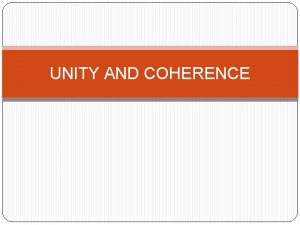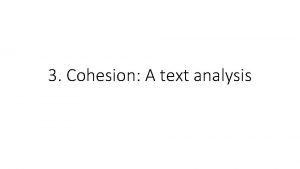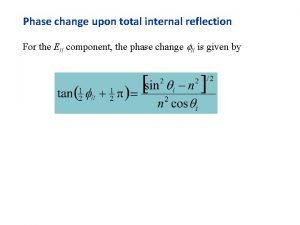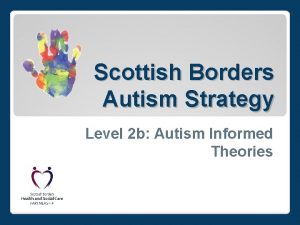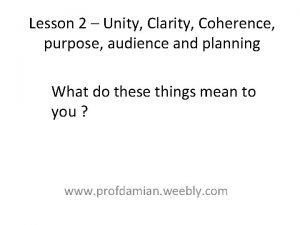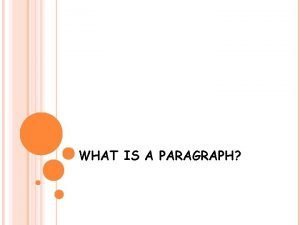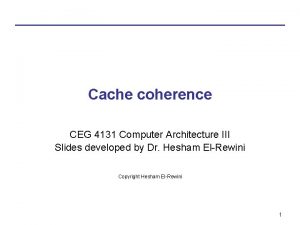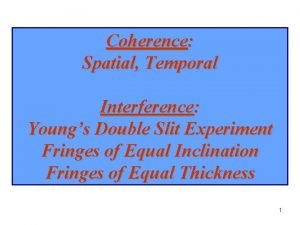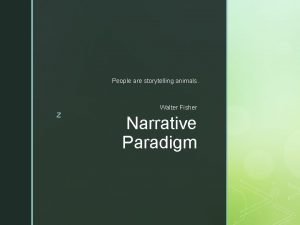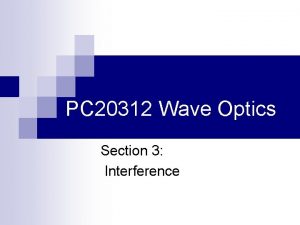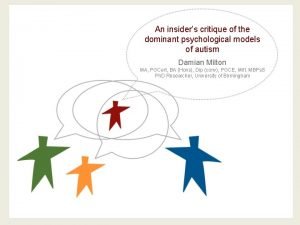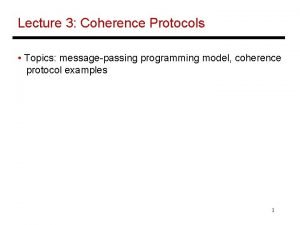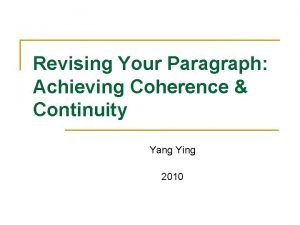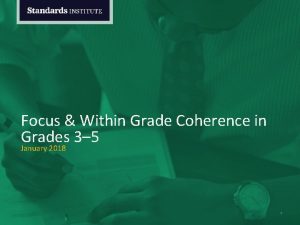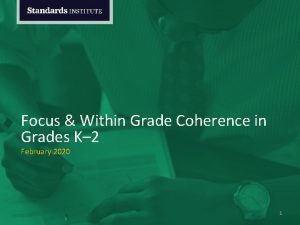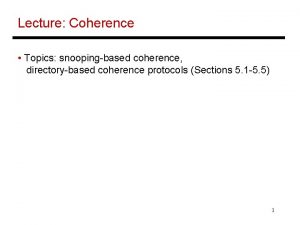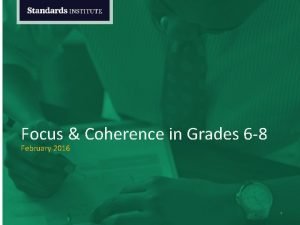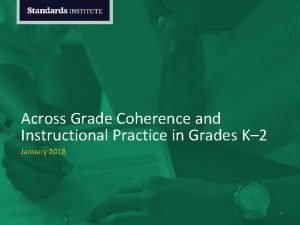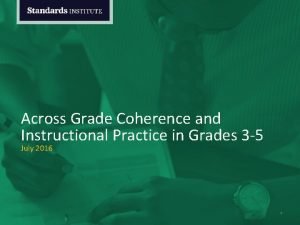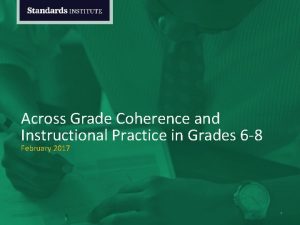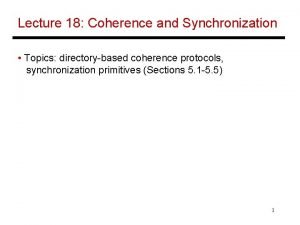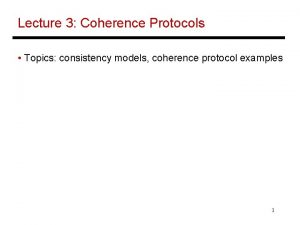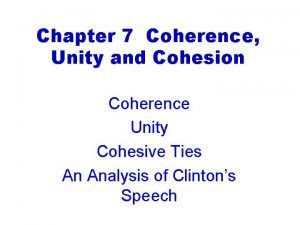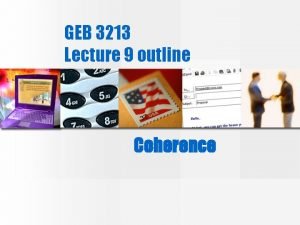Focus Within Grade Coherence in Grades 6 8
























































- Slides: 56

Focus & Within Grade Coherence in Grades 6– 8 July 2018 1

We know from experience the hard work teachers face every day as they strive to help all of their students meet the challenges set by higher Standards. We are a diverse team of current and former classroom teachers, curriculum writers, school leaders, and education experts who have worked in the public, private, and nonprofit sectors. We are dedicated to empowering teachers by providing free, high-quality, Standards-aligned resources for the classroom, the opportunity for unbiased and immersive training through our Institutes, and the option of support through our website offerings. 2

FOCUS IN GRADES 6– 8 Introduction: Who I Am Insert photo Name 1 • • Name 2 • • • 3

FOCUS IN GRADES 6– 8 Introduction: Who You Are Raise your hand if… • • You are a math teacher coach. You hold a different role. You teach in a district school. You teach in a charter school. You teach or work in a different type of school or organization. You teach monolingual students. You teach bilingual or multilingual students. 4

FOCUS IN GRADES 6– 8 Icebreaker Share with the people at your table: • Where are you from? • What do you do? • What gets you up in the morning? No, seriously, why do you do this work? Look at the cluster headings on your table. As a group, decide which three clusters you would spend the most time teaching and why. 5

FOCUS IN GRADES 6– 8 The Shifts 1. Focus strongly where the Standards focus. 2. Coherence: Think across grades, and link to major topics within grades. 3. Rigor in major topics: Pursue conceptual understanding, procedural skill and fluency, and application with equal intensity. 6

FOCUS IN GRADES 6– 8 This Week Day Ideas Monday Focus and Within Grade Coherence Tuesday Wednesday Rigor and the Mathematical Practices Across Grade Coherence and Instructional Practice Thursday Adaptation and Curriculum Study Friday Adaptation and Practice “Do the math” Equity for all Connect to our practice 7

FOCUS IN GRADES 6– 8 We Will… • Go deeper on standards and shifts and see how they play out in curriculum and instruction. • Examine standards-aligned resources. • Do a lot of math problems. • Think about how we can ensure equitable math instruction for all students. • Think about how what we are learning impacts what we will do in school. 8

FOCUS IN GRADES 6– 8 We Take Data Seriously • Three-minute online Daily Survey. Facilitators will address feedback the following day. • Thursday—tenminute online Knowledge Survey Post-Test. Answer key will be available. 9

FOCUS IN GRADES 6– 8 Norms That Support Our Learning • Take responsibility for yourself as a learner. • Honor timeframes (start, end, and activity). • Be an active and hands-on learner. • Use technology to enhance learning. • Strive for equity of voice. • Contribute to a learning environment in which it is “safe to not know. ” • Identify and reframe deficit thinking and speaking. 10

FOCUS IN GRADES 6– 8 Today • Morning: Focus in Grades 6– 8 • Afternoon: Focus and Within Grade Coherence in Grades 6– 8 11

FOCUS IN GRADES 6– 8 Morning Objectives • Participants will be able to describe the structure of the standards and how it translates to the learning and teaching of mathematics. • Participants will be able to identify clusters of standards as major, supporting, or additional. • Participants will be able to explain how specific content supports learning and teaching of major work. • Participants will be able to explain how attending to the shift of focus is an equitable practice in Standards-aligned math instruction. 12

FOCUS IN GRADES 6– 8 Morning Agenda I. Framing the Challenge II. Understanding Focus III. Major, Supporting, and Additional Content IV. Deeper Dive: Major Work 13

FOCUS IN GRADES 6– 8 I. Framing the Challenge 14

FOCUS IN GRADES 6– 8 Our Approach Our learning is grounded in the intersection of the standards, content, aligned curriculum, and the equitable instructional practices that are essential for closing the opportunity gap caused by systemic bias and racism. 15

FOCUS IN GRADES 6– 8 Unpacking Equity exists when the biases derived from dominant cultural norms and values no longer predict or influence how one fares in society. Equity systematically promotes fair and impartial access to rights and opportunities. Equity may look like adding supports and scaffolds that result in fair access to opportunities or creating opportunities for all voices to be heard. Educational Equity ensures that all children—regardless of circumstances—are receiving highquality, grade-level, and standards-aligned instruction with access to high-quality materials and resources. We become change agents for educational equity when we acknowledge that we are part of an educational system that holds policies and practices that are inherently racist and that we have participated in this system. We now commit to ensuring that all students, regardless of how we think they come to us, leave us having grown against grade-level standards and confident in their value and abilities. 16

FOCUS IN GRADES 6– 8 Equity—Envision It So You Can See It For educators, it is important to have a clear vision of what educationally equitable environments look like. Gorski and Swalwell provide five principles to guide you. 4 min. – Jot down concrete examples of what an equitable education environment would look like, sound like, and feel like to students, families, and staff. 6 min. – Share in pairs at your tables, looking for commonalities and new ideas to expand your thinking. 5 min. – Share with the whole group ideas you heard that will help all of us. Looks Like Sounds Like Feels Like 17

FOCUS IN GRADES 6– 8 II. A Call for Focus “A focused, coherent progression of mathematics learning, with an emphasis on proficiency with key topics, should become the norm in elementary and middle school mathematics curricula. Any approach that continually revisits topics year after year without closure is to be avoided. By the term focused, the Panel means that curriculum must include (and engage with adequate depth) the most important topics underlying success in school algebra…. Improvements like those suggested in this report promise immediate positive results with minimal additional cost. ” –National Mathematics Advisory Panel 18

FOCUS IN GRADES 6– 8 Focus in the Standards The Common Core calls for greater focus in mathematics. Rather than racing to cover many topics in a mile-wide, inch-deep curriculum, the Standards ask math teachers to significantly narrow and deepen the way time and energy are spent in the classroom. This means focusing deeply on the major work of each grade. 19

FOCUS IN GRADES 6– 8 Why Focus? This focus will help students gain strong foundations, including a solid understanding of concepts, a high degree of procedural skill and fluency, and the ability to apply the math they know to solve problems inside and outside the classroom. 20

FOCUS IN GRADES 6– 8 Review Grade Level Domain Cluster Standard 21

FOCUS IN GRADES 6– 8 Where to Focus? 22

FOCUS IN GRADES 6– 8 Focus by Grade Level This shows where students and teachers should spend the large majority of their time in order to meet the expectations of the Standards. • Not all content in a given grade is emphasized equally in the Standards. • Some clusters require greater emphasis than others based on the depth of the ideas, the time that they take to master, and/or their importance to future mathematics or the demands of college and career readiness. • More time in these areas is also necessary for students to meet the Standards for Mathematical Practice. • To say that some things have greater emphasis is not to say that anything in the Standards can safely be neglected in instruction. Neglecting material will leave gaps in student skill and understanding and may leave students unprepared for the challenges of a later grade. 23

FOCUS IN GRADES 6– 8 III. Focus by Grade Level • Major clusters are the highest priority. • Supporting clusters are designed to support and strengthen areas of major emphasis. • Additional clusters may not connect tightly or explicitly to the major work. 24

FOCUS IN GRADES 6– 8 Focus by Grade Level Protocol—Major Work 1. 2. 3. 4. Read the focus document for your grade(s). Identify the major work for the other grades in this gradeband. Identify themes for major work across this gradeband. 25

“Deficit views of historically marginalized children, their families, and communities because of race, class, language, and culture persist in educational conversations and research (Valencia, 2010)…. Deficit thinking implies that students ‘lack’ knowledge and experiences expected by the dominant group. ” —National Council of Supervisors of Mathematics and TODOS: Mathematics for ALL, 2016 26

FOCUS IN GRADES 6– 8 IV. Digging Into Major Work Protocol: 1. Do the math—one task per grade. 2. Identify the standard and why the task aligns. 3. Discuss the alignment with a partner at your table. 4. Explain how you could ensure equitable math instruction for all students with regard to the tasks you choose. 27

FOCUS IN GRADES 6– 8 Major Work—Grade 6 6. RP. A. 3 Jasmine has taken an online boating safety course and is now completing her end-of-course exam. As she answers each question, the progress bar at the bottom of the screen shows what portion of the test she has finished. She has just completed Question 16 and the progress bar shows she is 20% complete. How many total questions are on the test? Use a table, diagram, or equation to justify your answer. 28

FOCUS IN GRADES 6– 8 Major Work—Grade 7 7. RP. A. 1 Molly runs 1/3 of a mile in 4 minutes. a. b. If Molly continues at the same speed, how long will it take her to run one mile? Draw and label a picture showing why your answer to part (a) makes sense. 29

FOCUS IN GRADES 6– 8 Major Work—Grade 8 8. FA. 1 The following table shows the amount of garbage that was produced in the US each year between 2002 and 2010 (as reported by the EPA). Let's define a function which assigns to an input t (a year between 2002 and 2010) the total amount of garbage, G, produced in that year (in million tons). To find these values, you can look them up in the table. a. How much garbage was produced in 2004? b. In which year did the US produce 251 million tons of garbage? c. Does the table describe a linear function? d. Draw a graph that shows this data. 30

Lunch 12: 00– 1: 00 31

FOCUS AND WITHIN GRADE COHERENCE IN GRADES 6– 8 Today • Morning: Focus in Grades 6– 8 • Afternoon: Focus and Within Grade Coherence in Grades 6– 8 32

FOCUS AND WITHIN GRADE COHERENCE IN GRADES 6– 8 Afternoon Objectives • Participants will be able to identify connections between content within a grade level. • Participants will be able to evaluate a sample scope and sequence by • determining whether or not it covers grade-level content; • evaluating the amount of time spent on major, supporting, and additional work; and • recognizing purposeful connections between content (i. e. , between major and supporting and between major and major). 33

FOCUS AND WITHIN GRADE COHERENCE IN GRADES 6– 8 Afternoon Agenda I. Deeper Dive: Supporting Work II. Connect to Practice: Impact of Focus III. Coherence Within the Grade IV. Connect to Practice: Evaluate a Scope and Sequence 34

FOCUS AND WITHIN GRADE COHERENCE IN GRADES 6– 8 I. Digging Into Supporting Work Protocol 1. Identify the supporting work for your grade(s) using the focus documents. 2. Do the math—identify the standard. 3. Discuss how this standard supports major work. 35

FOCUS AND WITHIN GRADE COHERENCE IN GRADES 6– 8 Supporting in Grade 6 6. G. A. 2 36

FOCUS AND WITHIN GRADE COHERENCE IN GRADES 6– 8 Supporting in Grade 7 7. SP. C. 6 Each of the 20 students in Mr. Anderson's class flipped a coin ten times and recorded how many times it came out heads. a. How many heads do you think you will see out of ten tosses? b. Would it surprise you to see 4 heads out of ten tosses? Explain why or why not. c. Here are the results for the twenty students in Mr. Anderson's class. Use this data to estimate the probability of observing 4, 5, or 6 heads in ten tosses of the coin. (It might help to organize the data in a table or in a dot plot first. ) 37

FOCUS AND WITHIN GRADE COHERENCE IN GRADES 6– 8 Supporting in Grade 8 8. SP. A. 1 Medhavi suspects that there is a relationship between the number of text messages high school students send and their academic achievement. To explore this, she asks each student in a random sample of 52 students from her school how many text messages he or she sent yesterday and what his or her grade point average (GPA) was during the most recent marking period. The data are summarized in the scatter plot of number of text messages sent versus GPA shown below. Describe the relationship between number of text messages sent and GPA. Discuss both the overall pattern and any deviations from the pattern. 38

FOCUS AND WITHIN GRADE COHERENCE IN GRADES 6– 8 II. Focus in 6– 8 Connection to practice: • What are the common threads in the major work in Grades 6– 8? • How do supporting clusters connect to the major work? • What impact do the focus documents have on your role? Why does a focused curriculum lead to greater student success for all students? • 39

FOCUS AND WITHIN GRADE COHERENCE IN GRADES 6– 8 III. Coherence Within the Grade 40

Within Grade Coherence: Coherence is built into the standards for each grade through the utilization of complementary topics to support and reinforce a major topic in a grade. This also increases focus in the grade.

FOCUS AND WITHIN GRADE COHERENCE IN GRADES 6– 8 Task Analysis Protocol: 1. Do the math—one task per grade. 2. Identify the standards and why the task aligns. 3. Stronger and Clearer Each Time: a. Write why this connection is important to discuss with students. b. Discuss why this connection is important to show to students with someone who is in a similar role. c. Revise your writing on why this connection is important based on your conversation. 42

FOCUS AND WITHIN GRADE COHERENCE IN GRADES 6– 8 Grade 6 6. RP. A. 3 and 6. EE. B. 7 A fruit salad consists of blueberries, raspberries, grapes, and cherries. The fruit salad has a total of 280 pieces of fruit. There are twice as many raspberries as blueberries, three times as many grapes as cherries, and four times as many cherries as raspberries. How many cherries are there in the fruit salad? 43

FOCUS AND WITHIN GRADE COHERENCE IN GRADES 6– 8 Grade 7 7. RP. A. 3, 7. EE. B. 3 and 7. RP. A. 2 1. In New York, state sales tax rates vary by county. In Allegany County, the sales tax rate is 8 ½ %. a. b. c. A book costs $12. 99, and a video game costs $39. 99. Rounded to the nearest cent, how much more is the tax on the video game than the tax on the book? Using �� to represent the cost of an item in dollars before tax and �� to represent the amount of sales tax in dollars for that item, write an equation to show the relationship between �� and ��. Using your equation, create a table that includes five possible pairs of solutions to the equation. Label each column appropriately. 44

FOCUS AND WITHIN GRADE COHERENCE IN GRADES 6– 8 Grade 8 8. F. B. 4 and 8. EE. C. 8. C A customer is comparing two different text message plans at Cellular Bargains. He wants to find out which plan allows the most text messages for the same cost. The Pay Per Text Plan charges $10 per month and $0. 10 for each text message. Write a function that models this plan, stating what your variables represent. The Frequent Text Plan is modeled by the graph shown below. How many text messages would result in the same cost per month for the two plans? 45

FOCUS AND WITHIN GRADE COHERENCE IN GRADES 6– 8 Reflection • How will the discussion on within grade coherence impact what you do in school? • Has your thinking about curriculum, instruction, or lesson planning changed given the discussion on focus and within grade coherence? How? • What have you thought about doing to ensure equitable math instruction for all students in your class? 46

Break

FOCUS AND WITHIN GRADE COHERENCE IN GRADES 6– 8 IV. Connect to Practice “A focused, coherent progression of mathematics learning, with an emphasis on proficiency with key topics, should become the norm in elementary and middle school mathematics curricula. Any approach that continually revisits topics year after year without closure is to be avoided. By the term focused, the Panel means that curriculum must include (and engage with adequate depth) the most important topics underlying success in school algebra…. Improvements like those suggested in this report promise immediate positive results with minimal additional cost. ” –National Mathematics Advisory Panel 48

FOCUS AND WITHIN GRADE COHERENCE IN GRADES 6– 8 Connect to Practice • How do we know if our curriculum is focused and coherent? • What are the focus criteria? • What are the coherent criteria? 49

FOCUS AND WITHIN GRADE COHERENCE IN GRADES 6– 8 Connect to Practice Focus Criteria • Focus on grade-level standards • Appropriate emphasis on major work Coherence Criteria • Complementary topics support and reinforce a major topic • Supporting work integrated with major work 50

FOCUS AND WITHIN GRADE COHERENCE IN GRADES 6– 8 Evaluate a Sample Scope and Sequence Look at the sample scope and sequence. • Does the scope and sequence appropriately focus on grade-level standards and focus on major content? What evidence do you have? • Does the scope and sequence appropriately reflect the idea of within grade coherence? What evidence do you have? Focus Criteria • Focus on grade-level standards • Appropriate emphasis on major work Evidence of Focus Coherence Criteria • Complementary topics support and reinforce a major topic • Supporting work integrated with major work Evidence of Within Grade Coherence Ways to Improve/What I Want to Investigate Further 51

FOCUS AND WITHIN GRADE COHERENCE IN GRADES 6– 8 Evaluate Your Scope and Sequence Look at the scope and sequence or curriculum map that you brought with you today. • Does the scope and sequence appropriately focus on grade-level standards and focus on major content? What evidence do you have? • Does the scope and sequence appropriately reflect the idea of within grade coherence? What evidence do you have? Focus Criteria • Focus on grade-level standards • Appropriate emphasis on major work Evidence of Focus Coherence Criteria • Complementary topics support and reinforce a major topic • Supporting work integrated with major work Evidence of Within Grade Coherence Ways to Improve/What I Want to Investigate Further 52

FOCUS AND WITHIN GRADE COHERENCE IN GRADES 6– 8 Evaluate Your Scope and Sequence Further reflection: • How will the focus shift impact your work with creating and/or coaching around scope and sequences? • How will within grade coherence impact your work with creating and/or coaching around scope and sequences? • How does attending to the shifts of focus and within grade coherence contribute to an equitable environment in your math class? 53

Feedback Please fill out the survey located here: www. standardsinstitutes. org. • Click “Summer 2018” on the top of the page. • Click “Details” on the center of the page. 54

About This Deck • Copyright © 2018 Unbound. Ed Learning, Inc. • This work is licensed under a Creative Commons Attribution Non. Commercial Share. Alike 4. 0 International License. • Unbound. Ed Learning, Inc. is the copyright holder of the images and content, except where otherwise indicated in the slide notes. • More information on Creative Commons’ licenses can be found here: https: //creativecommons. org/licenses/. 55

How You Can Use This Deck The materials that we create, unless otherwise cited in the slide notes, are licensed under the Creative Commons Attribution-Non. Commercial-Share. Alike 4. 0 International license (CC BYNC-SA 4. 0). This means you may: • Share—copy and redistribute the material in any medium or format • Adapt—remix, transform, and build upon the material As long as you follow the license terms: • Provide Attribution—You must give appropriate credit, provide a link to the license, and indicate if changes were made. You may do so in any reasonable manner, but not in any way that suggests that Unbound. Ed or any third party creator endorses you or your use. • No Commercial Use—You may not use the material for commercial purposes. • Share. Alike—If you remix, transform, or build upon the material, you must distribute your contributions under the same license as the original. • No Additional Restrictions—You may not apply legal terms or technological measures that legally restrict others from doing anything the license permits. 56
 Focus and coherence
Focus and coherence Porters generic competitive strategies
Porters generic competitive strategies Differentiation cost leadership
Differentiation cost leadership Actor focus vs object focus
Actor focus vs object focus Prolepsis
Prolepsis Interactions within ecosystems grade 7
Interactions within ecosystems grade 7 Cohérence info
Cohérence info Cache coherence nedir
Cache coherence nedir Pragmatism theory of truth example
Pragmatism theory of truth example Unity in academic writing
Unity in academic writing V number in optical fiber
V number in optical fiber Seed paragraph
Seed paragraph Scattering of light definition
Scattering of light definition Example of a clincher
Example of a clincher Unity coherence
Unity coherence Narrative coherence and fidelity examples
Narrative coherence and fidelity examples How do unity and coherence help in paragraph structure
How do unity and coherence help in paragraph structure Embedded figures test
Embedded figures test Huygens principle example
Huygens principle example Discourse example sentence
Discourse example sentence Types of raman amplifier
Types of raman amplifier Pgcps coherence framework
Pgcps coherence framework Cache coherence tutorial
Cache coherence tutorial Pippard coherence length
Pippard coherence length Curriculum design coherence model
Curriculum design coherence model Coherence in waves
Coherence in waves Cohesion and coherence
Cohesion and coherence Cooper pairs animation
Cooper pairs animation Spatial coherence
Spatial coherence Define coherence and cohesion
Define coherence and cohesion How do unity and coherence help in paragraph structure
How do unity and coherence help in paragraph structure Cache coherence example
Cache coherence example Tagxedo about unity and coherence
Tagxedo about unity and coherence What is cohesion and coherence
What is cohesion and coherence Generation of conceptual coherence
Generation of conceptual coherence Temporal and spatial coherence
Temporal and spatial coherence Coherence data grid
Coherence data grid Central coherence theory autism
Central coherence theory autism Reiteration examples
Reiteration examples Gpu cache coherence
Gpu cache coherence Coherence and clarity
Coherence and clarity Emc unity snapshot
Emc unity snapshot Types of paragraphs
Types of paragraphs Define coherence and cohesion
Define coherence and cohesion Coherence in essay writing
Coherence in essay writing Unity and coherence
Unity and coherence Transition words for essays 6th grade
Transition words for essays 6th grade Chained cache coherence protocol
Chained cache coherence protocol What is temporal and spatial coherence
What is temporal and spatial coherence Example of topic sentence and supporting details
Example of topic sentence and supporting details Unity and coherence
Unity and coherence Narrative coherence and fidelity examples
Narrative coherence and fidelity examples What is temporal and spatial coherence
What is temporal and spatial coherence Central coherence theory autism
Central coherence theory autism Cache coherence protocols
Cache coherence protocols Coherence associates
Coherence associates Example of coherence and cohesion
Example of coherence and cohesion






